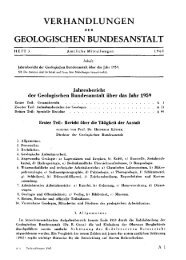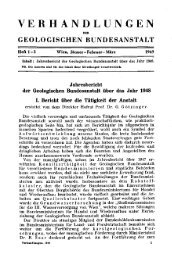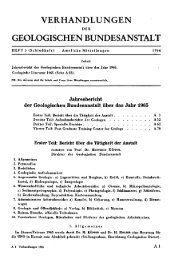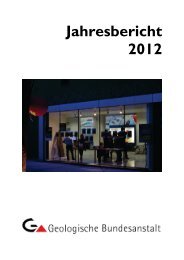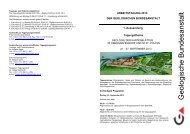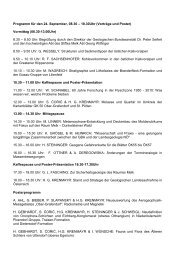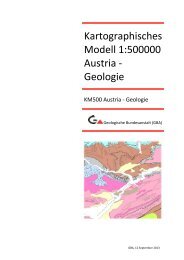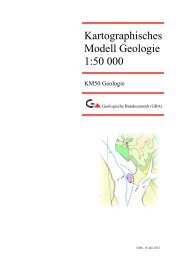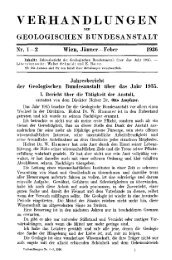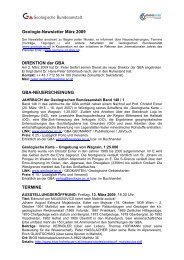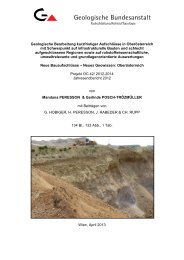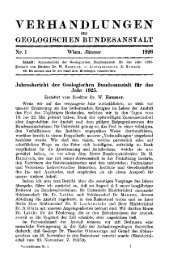Field Trip B TRIASSIC CONODONT LOCALITIES OF THE ...
Field Trip B TRIASSIC CONODONT LOCALITIES OF THE ...
Field Trip B TRIASSIC CONODONT LOCALITIES OF THE ...
Create successful ePaper yourself
Turn your PDF publications into a flip-book with our unique Google optimized e-Paper software.
the section at Feuerkogel apparently is one of the most important Triassic conodont occurrence in the<br />
world. The following platform conodont species can be found in considerable numbers: Gl. tethydis,<br />
G. excelsa, G. polygnathiformis, G. nodosa, G. navicula, M. communisti (morphotype A + B), E. primita<br />
and E. abneptis s. str.<br />
Due to the results from many detailed and short ranging sections and numerous stratigraphic data<br />
the conodont faunas will not be dealt separately but will be included in the description of the following<br />
sections.<br />
Austriacum-Lager (F 1, figs. 10 and 11)<br />
This fossil site is located on the southern slope close to the peak of FeuerkogeL It is characterized<br />
by a bif scree coming from a 30m long and 2m high quarry which resulted from many years of collecting<br />
cephalopods. Up to 1970 in the outcrop only Lower Norian „Hellkalk'.' and the Halobia styriacalumachelle<br />
were exposed; by that time the,,Rotkalke" with its famous fossil layers were buried under<br />
meters of rock debris. This explains why MOSHER 1968 failed to find any traces of the Trachyceras<br />
beds in the outcrop. All samples collected by him were derived from Lower Norian beds only exposed.<br />
During the years 1971, 1976 and 1977 systematic ditches were made to enlarge the quarry and to expose<br />
its base.<br />
The section (fig. 10) starts with unfossiliferous „Rotkalke" which yielded Ladinian conodonts such as<br />
G. excelsa, G. trammeri and Carinella hungarica. These limestones are followed by an extraordinary<br />
rich fossil bed (76/2 in fig. 10) containing a condensed ammonite fauna of Upper Ladinian and lowermost<br />
Karnian age (Julian 1 according to KRYSTYN 1978); also, conodonts reflect condensation. In<br />
the western part of the quarry (section described by KRYSTYN 1973, fig. 3) the same bed embraces<br />
upper Lower Karnian (Austriacum Zone).<br />
76/5 •<br />
76/6 •<br />
76/2 •<br />
76/1 •<br />
FEUERKOGEL (Steinbrüche Fl und F5)<br />
Qw<br />
OX) aß<br />
£$&><br />
-lb I<br />
-(a)<br />
Fl<br />
Trachyceras austriacum,<br />
Sirenites, Neoprotrachyceras<br />
n gen<br />
Basis der Austriacum-Zone<br />
Trachyceras aonoides, Diptosireniles.<br />
Sirenotrachyceras<br />
Doonella n.sp 1 " ° en<br />
-0,5<br />
F5<br />
Trachyceras cf. aonoides (bl<br />
Basis der Aonoides- Subzone<br />
Trachyceras oon. Trachy- fa I<br />
ceras brotheus. Lobites<br />
Kondensationshorizont mitD.lommeli (O.Ladin-U.Karn)<br />
Fig. 10: Upper Ladinian to Lower Karnian sequence at the quarries Fl and F5 of Feuerkogel showing vertical distribution<br />
of conodont samples. Correlation of beds based on ammonoid evidence. From KRYSTYN 1978.<br />
In the middle part the above mentioned bed is succeeded by a thin „Black horizon" which has been<br />
known from all fossil sites at Feuerkogel and thus represents a marker-bed. According to the ammonites<br />
it is assigned to the upper Julian 1 (Aonoides Subzone). The layer contains rare and fragmentary<br />
specimens of Gladigondolella tethydis and Gondolella polygnathiformis.<br />
The next bed is composed of a light red to yellowish red limestone showing lense-like shape. It begins<br />
in the eastern part of Fl-W with a thickness of 20 cm (fig. 10, section Fl), reaches its maximum<br />
thickness in section Fl-E with 60 cm and thins towards the east after 5 m. It was designated as typehorizon<br />
of the Austriacum Zone as defined by KRYSTYN 1978 and contains a rich invertebrate fauna.<br />
The ammonite fauna comprises the following genera: Trachyceras (Austrotrachyceras), Sirenites, Neoprotrachyceras,<br />
Joannites, Proarcestes, Monophyllites, and Pompeckjites (a pinacoceratid). A more detailed<br />
list can be found in KRYSTYN 1978, p. 58 (for detailed description see MOJSISOVICS 1893).<br />
The rich platform conodont fauna (samples 76/6 and 77/40) is composed exclusively of Gladigondo-<br />
F5/IX<br />
F5/X<br />
F5/XIII<br />
83



